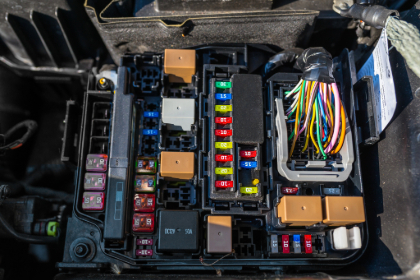INDEPENDENT DEALER
Fort Worth, TX & Southlake | (888) 459-9958 / (817) 431-6664
Ace Hi Oil
OUR BLOG
08/07/2025
Replacing a fuse may sound technical, but it’s one of the most beginner-friendly maintenance tasks you can do. Learn how to replce a blown fuse with this step-by-step guide that Ace Hi Oil in Fort Worth, TX has for you.

If your car’s radio suddenly goes silent, your windows stop rolling down, or your headlights won't turn on, it might not be a major electrical issue. In fact, it could be something as simple—and fixable—as a blown fuse.
Replacing a fuse is one of the most straightforward car maintenance tasks you can do yourself. It doesn’t require any advanced tools or experience, just a little know-how and a few minutes of your time. Here’s a practical, easy-to-follow guide to get you back on the road—without a trip to the mechanic.
Call Ace Hi Oil in Fort Worth, TX, at (817) 431-6664 or visit AMSOIL's online store to protect your vehicle and keep it working perfectly.
How to Replace a Blown Fuse
What Does a Fuse Do, and Why Do They Blow?
Your vehicle’s fuses are safety devices that protect the electrical system. Each fuse is designed to “blow” (break the circuit) if there’s too much current flowing to a component, like your stereo, headlights, or power windows. When a fuse blows, it prevents damage to the wiring and electronics.
Fuses blow most commonly due to short circuits, faulty wiring, or an overloaded system. Luckily, they’re inexpensive to replace and often the cause of minor issues.
Step 1: Identify What’s Not Working
The first step is figuring out which system or component has failed. Are the power windows not working? Is the interior lighting off? This helps you zero in on the correct fuse to check.
Once you know what’s malfunctioning, refer to your owner’s manual. Most manuals include a fuse diagram that maps out which fuses control which systems.
No manual? You can usually find a copy online by searching your vehicle’s make, model, and year.
Step 2: Locate the Fuse Box
Most vehicles have two fuse boxes:
- One inside the cabin: typically located under the dashboard, near the steering column or glovebox.
- One under the hood: usually near the battery or fender.
Open the fuse box cover and look for a diagram (often printed inside the lid) to help identify the fuse associated with the malfunctioning component.
Step 3: Inspect the Fuse
Carefully remove the fuse using your fingers, a pair of needle-nose pliers, or the fuse puller tool (usually included in the fuse box).
Hold the fuse up to the light:
- If the metal strip inside is intact, the fuse is still good.
- If the strip is broken or blackened, the fuse has blown and needs to be replaced.
Not sure? If it looks even slightly damaged, it’s best to replace it just to be safe.
With AMSOIL's Signature Series 0W-20 Synthetic Motor Oil, the best synthetic oil in Fort Worth, TX, you can make sure your engine stays strong.
Step 4: Replace It with the Correct Type
Here’s where it’s critical: Replace the blown fuse with one that has the exact same amperage rating. This number is usually printed on the top of the fuse (e.g. 10, 15, 20) and is also color-coded.
- 10A – red
- 15A – blue
- 20A – yellow
- 30A – green
Installing the wrong type can lead to more serious electrical issues or even pose a fire hazard.
Push the new fuse into the slot until it’s secure.
Step 5: Test the System
Once the fuse is replaced, start your car and test the system or component that wasn’t working.
If it’s functioning again—great! You’ve successfully replaced a blown fuse.
If it’s still not working, or if the new fuse blows immediately, there may be an underlying issue like a short circuit or a faulty component. In that case, it’s best to consult a certified technician.
Pro Tip: Keep Spare Fuses in Your Vehicle
Fuses are inexpensive and don’t take up much space. Keep a spare fuse kit in your glove compartment or emergency toolkit—especially if you drive an older vehicle or frequently use aftermarket accessories (like dash cams or upgraded stereos) that draw extra power.
Most auto parts stores sell fuse kits for under $10 with a variety of amperage ratings.
Safety Reminders
- Never bypass a fuse with wire or metal. This creates a fire risk and can seriously damage your vehicle.
- If the same fuse keeps blowing, don’t keep replacing it. That’s a sign of a deeper electrical fault that needs professional diagnosis.
- Turn off your ignition before checking or replacing fuses to prevent shocks or electrical damage.
Call Ace Hi Oil in Fort Worth, TX, at (817) 431-6664 or visit AMSOIL's online store to buy products that will improve your vehicle’s performance.
CONTACT
Norman Rinehart
2900 Knight Ct
Southlake, TX, 76092
United States
United States
(888) 459-9958
(817) 431-6664